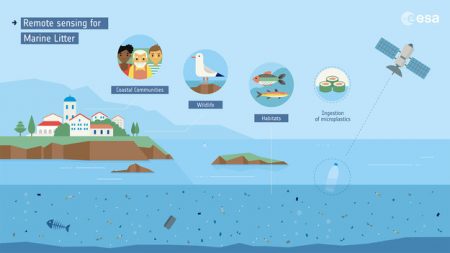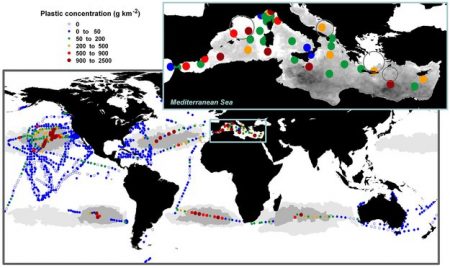March 22, 2018 – A new initiative by the European Space Agency (ESA) is using its Earth-observation satellites to measure concentrations of plastic in marine environments. Estimated to exceed 10 million metric tons annually, plastic when viewed from space provides a unique spectral signature. It is hoped that providing the data on the amount of ocean plastic will lead to an international call for action.

One of the satellites, Sentinel-3, includes instrumentation on board called an ocean-colour tracker, measuring subtle spectral changes from ocean surface imaging. ESA is deploying a program it calls OptiMAL which stands for Optical Method for Marine Litter Detection. Combining their global observations with work being done out of California to create aerial ocean surveys using high-spatial-resolution cameras on C-130 Hercules aircraft, and satellite bathymetric lidar, hyperspectral shortwave infrared imaging, it is the hope that accurate maps can be created. OptiMAL is capable of detecting a range of litter going from larger pieces to microplastics with diameters of less than 5 millimeters suspended in the upper layers of the ocean, as well as plastic debris found on shorelines.
States ESA’s Paolo Corradi, one of the program leads states, “Simulations are all well and good, but an image based on actual measurements would provide important insights to scientists and would hold greater power for the public and policymakers alike.”
Initial data results with maps were presented at the Sixth International Marine Debris Conference in San Diego, California held earlier this month.
Understanding the extent of marine plastic pollution requires hard evidence. The ideas presented at the San Diego conference represent a good start in attempting to address the problem on a global scale.
Ultimately solutions to roll back the tide of marine plastic debris will be needed to free the ocean from plastics of varying sizes found throughout the entire water column, from the seabed to the surface. States Corradi, “Monitoring is not a goal in itself, but a means to show the scale of the problem, and start to try and solve it.”

Interested in learning about solutions for collecting all that plastic in the ocean? Read about some of the novel inventions that may help us begin to put an end to marine plastic pollution including a marine robot drone capable of capturing microplastics in the depths of the ocean.








